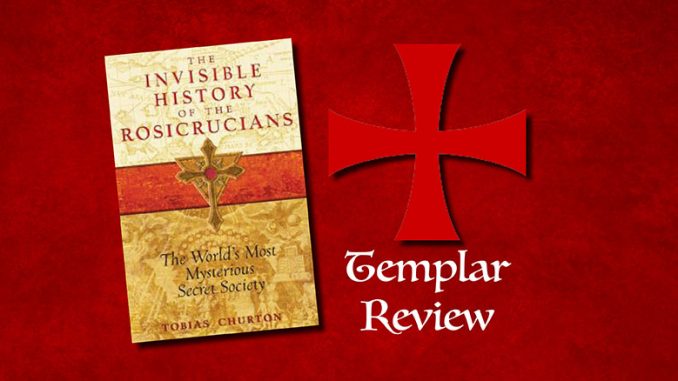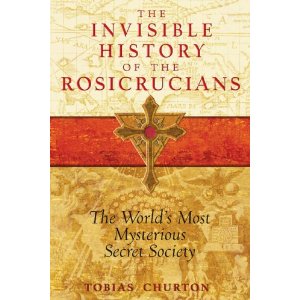
Invisible History of the Rosicrucians by Tobias Churton
Paperback: 576 pages
Publisher: Inner Traditions
Language: English
ISBN: 978-1-59477-255-9
Reviewed by Randy Williams
 The Invisible History of the Rosicrucians is author Tobias Churton’s ambitious attempt to create the definitive book on a complex and oft-misunderstood subject. Churton, perhaps best known for his works on Gnostic writings and philosophy, is a lecturer at the Exeter University (UK) master’s program in Western Esotericism and is considered one of the world’s foremost experts on hidden wisdom and secret societies. He has touched on the Rosicrucians in his writing before, most notably in 2002’s excellent pre-history of Freemasonry, The Golden Builders. That book, however, only hinted at the exhaustive scope and detail to be found in The Invisible History of the Rosicrucians, which at nearly 600 pages outdoes even Churton’s similarly weighty tome on the Craft, 2007’s Freemasonry: The Reality.
The Invisible History of the Rosicrucians is author Tobias Churton’s ambitious attempt to create the definitive book on a complex and oft-misunderstood subject. Churton, perhaps best known for his works on Gnostic writings and philosophy, is a lecturer at the Exeter University (UK) master’s program in Western Esotericism and is considered one of the world’s foremost experts on hidden wisdom and secret societies. He has touched on the Rosicrucians in his writing before, most notably in 2002’s excellent pre-history of Freemasonry, The Golden Builders. That book, however, only hinted at the exhaustive scope and detail to be found in The Invisible History of the Rosicrucians, which at nearly 600 pages outdoes even Churton’s similarly weighty tome on the Craft, 2007’s Freemasonry: The Reality.
The reason why the Rosicrucians are (according to the book’s subtitle) the world’s most mysterious secret society, and why their history continues to be so widely misunderstood, is because the fraternal Brothers of the Rosy Cross were never actually meant to exist. The earliest Rosicrucian documents — Fama Fraternitatis, Confession Fraternitatis, and The Chymical Wedding of Christian Rosenkreutz (originating from 1607) — were written anonymously but can be traced to Germany and the pen of a young Lutheran seminary student named Johannes Valentinus Andreae. Churton asserts that the documents were written as a sort of a youthful university prank or “game,” using the allegory of a fictional mystic named Christian Rosenkreutz and his equally fictional fraternity of followers as a means of critiquing the prevailing stodginess of the 17th-century religious and educational establishments. Andreae, who became a member of the Lutheran clergy, took pains to distance himself from both the Fama and the Confession; he admitted to writing only The Chymical Wedding. According to Churton, Andreae was horrified to discover that his anonymous, youthful manifestos had been published several years after they were written, and he later became angry when other writers, claiming to be leading members of the fictional fraternity, began to steer what was purported to be “Rosicrucian thought” in new directions, encompassing ever-heavier doses of magic, alchemy and astrology. Andreae’s later writing under his own name openly ridicules alchemists; his original manifestos had a much stronger connection to medical sciences, advocating that Brothers of the Rosy Cross should care for the sick and infirm free of charge.
Once published, the manifestos took on a life of their own as they spread throughout Europe. New Rosicrucian books began appearing almost immediately, all written by authors claiming to be members of the non-existent order. Several of the authors faced persecution (after all, the Inquisition was still active in many parts of Europe); a great many others sought to set themselves up as the heads of “real” Rosicrucian orders. Churton chronicles more than three centuries of attempts by writers, would-be prophets, and creators of fraternal ritual to manufacture authentic ties to the mythical brotherhood, a pursuit which has seen the creation of a great many forged documents and outlandish tale tales that stretch credulity to the breaking point. Some of these writers went so far as to claim that Christian Rosenkreutz was not even the founder of the order, but that the “true” beginnings of the brotherhood could be traced back to ancient Egypt (this was a popular claim in fringe Masonic degrees of the era as well). Most of these authors added their own spin and agendas, resulting in a body of “Rosicrucian” work that bears little relation to the original documents by Johannes Valentinus Andreae. It is Churton’s assertion that Andreae would likely disapprove of much, if not all of what has been done in the name of his fictional Christian Rosenkreutz. (In one section, Churton even states that the system of Christian mysticism based upon the writings of Louis-Claude de Saint-Martin and known as Martinism is closer to Andreae’s original ideas than is most of what is now called Rosicrucianism.) Even so, many modern-day seekers proudly call themselves Rosicrucians — finding illumination in the works of the latter-day Rosicrucian writers and participating in the flesh-and-blood fraternal orders they have inspired.
If there is a fault to be found with the book, it is that its structure feels somewhat unbalanced. The earliest sections of the story, which take place during Andreae’s lifetime and the century immediately following the “accidental” publication of his manifestos, consume almost 400 of the book’s pages and are almost too detailed. Churton occasionally gets bogged down in minutiae of dates and events and lets his narrative sag. By contrast, the latter sections which deal with the pseudo-Rosicrucian groups that have formed over the last three centuries (quite a few of which are still in existence) speed by in fewer than 200 pages and sometimes feel as if they skimp on detail. When one considers that this section of the story features such colourful characters as Arthur Edward Waite, Rudolf Steiner, Max Heindel, and even Aleister Crowley, this reader could not help but feel disappointed that it was not more fully developed. As well, the extent to which Rosicrucian ideas have influenced fraternal ritual, whether Masonic (most notably in the Scottish Rite degrees) or quasi-Masonic (the various “Societas Rosicruciana” groups that are open only to Freemasons) gets relatively short shrift.
These are, however, minor quibbles. Churton’s book is a remarkable achievement — an encyclopedic overview spanning 400 years of Rosicrucian history and philosophy that is written in an accessible, engaging, even warm and humorous tone that takes the subject seriously but never fails to spot the many ironies inherent in the unusual story. As the author succinctly states, “What began as a game became a religion.” The Invisible History of the Rosicrucians is certain to be the go-to source for information on this fascinating subject for many years to come.
PLEASE NOTE: This book was published simultaneously in the UK and Ireland by Lewis Masonic under the similar title Invisibles: The True History of the Rosicrucians (ISBN 978-0-85318-309-9).
About Us
TemplarHistory.com was started in the fall of 1997 by Stephen Dafoe, a Canadian author who has written several books on the Templars and related subjects.
Read more from our Templar Reviews & Interviews Archives – Templar History
